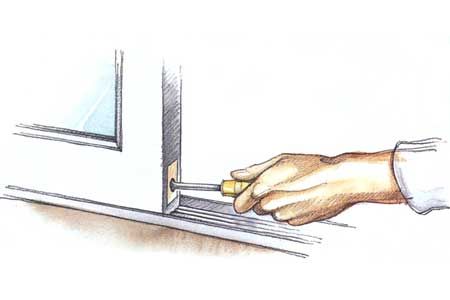Sliding doors offer easy access to outdoor spaces and let in lots of natural light. Unfortunately, these doors can develop issues over time that affect their operation. With proper care and the fixes in this guide, your door could last 20 years or more. Learn how to adjust your sliding door to save time, money, and frustration.
Components of a Sliding Door
Before attempting a repair, familiarize yourself with the basic components of your sliding door:
- Door panel: The main sliding portion of the door, usually made of glass or wood
- Track: The channel along which the door slides
- Rollers: Located at the bottom of the door, allowing it to glide smoothly along the track
- Guide: Positioned at the top of the door to keep it aligned
- Weatherstripping: Seals the door to prevent drafts and moisture infiltration
- Locking mechanism: Secures the door when closed
Common Issues With Sliding Doors
Next, diagnose the problem. Sliding doors can experience various problems that affect their functionality:
| Problem | Likely Root Causes |
|---|---|
| Crooked door | • Misalignment |
| Drafts or water leaks | • Cracked frame or glass • Misalignment • Worn weatherstripping |
| Gaps between the door and frame | • Cracked frame • Misalignment • Worn weatherstripping |
| Jumping off the track | • Misalignment |
| New or unusual noises | • Misalignment • Poor lubrication • Worn rollers |
| Sticking or difficult sliding | • Misalignment • Poor lubrication • Worn rollers |
Tools Required for Adjusting a Sliding Door
Gather the following tools before starting your repair:
- Adjustable wrench
- Clean cloths
- Flat pry bar
- Level
- Screwdrivers
- Silicone spray lubricant
- Stool or stepladder
- Vacuum cleaner with brush attachment
Step-by-Step Guide To Adjusting Your Sliding Door
Follow these steps to adjust your sliding door and restore smooth operation. Remember to make gradual adjustments and test the door frequently throughout the process.
Inspecting the Door Alignment
Inspect your door carefully before beginning any work:
- Fully open the door and inspect the top and bottom for any obvious misalignment.
- Use a level to check if the door is plumb (vertically straight) when closed.
- Check that the gap between the door and frame is consistent along all edges.
Adjusting the Bottom Rollers
The bottom rollers help your door slide smoothly. For some issues, a simple roller adjustment will fix the problem:
- Locate the adjustment screws at the bottom of the door. These are typically on the edge facing the jamb.
- If the side with the adjustment screw is too high, causing it to bind at the top, turn the screw counterclockwise. If it’s too low, use a flat pry bar to raise the door while you turn clockwise.
- Make small adjustments, testing the door after each turn.
- Aim for a uniform gap along the door’s bottom and top edges.
Fine-Tuning the Top Track
We recommend having at least two people present when adjusting the top track. This helps you stay safe if the glass door begins to tilt out of the frame:
- Check if the top track is straight using a level.
- If necessary, loosen the screws holding the track in place and adjust its position.
- Retighten the screws once the track is level.
- Test the door to ensure it slides smoothly without binding at the top.
Maintenance Tips for Smooth Sliding Door Operation
Follow these maintenance tips to prevent future issues.
Regular Cleaning Practices
We recommend cleaning your sliding door as needed:
- Vacuum the track to remove dirt and debris that can impede smooth operation.
- Wipe down the track and rollers with a damp cloth to remove any stubborn grime.
- Clean the glass and frame with appropriate cleaners.
- Inspect and clean weatherstripping to ensure a proper seal. Replace the weatherstripping every few years.
Lubrication Dos and Don’ts
You may need to lubricate your sliding door to improve usability.
| Do | Don’t |
|---|---|
| Lubricate vinyl tracks, or anywhere that’s metal-on-metal. | Lubricate the lock mechanism. This can interfere with its proper function. |
| Use a silicone-based lubricant sparingly on the rollers and track every few months. | Use oil-based or petroleum lubricants. They can attract dust and create a sticky residue. |
Troubleshooting Persistent Sliding Door Problems
Try these steps to repair your sliding door if it continues to stick after adjustments:
- Check for obstructions in the track and remove any debris.
- Inspect the rollers for damage and replace them if necessary.
- Ensure the track is clean and properly lubricated.
- Consider replacing worn weatherstripping that may be causing friction.
For doors that frequently come off the track, try this:
- Examine the track for any bends or damage.
- Check if the rollers are worn or broken, and replace them as needed.
- Make sure the door is properly aligned with the track.
- Tighten any loose screws in the track or roller assembly.
If these steps don’t resolve the issue, you may need to replace the entire track or door. In that scenario, we recommend getting professional help.
When To Call a Professional for Your Sliding Door
While you can solve many sliding door issues with DIY adjustments, some situations warrant professional guidance. We recommend calling in the pros in these cases:
- Complex alignment issues that persist after multiple adjustment attempts
- Cracked or shattered glass panels
- Installing a new sliding door system
- Severely bent or damaged tracks
- Structural damage to the door frame or surrounding wall
Professional installers have the expertise and tools to handle these more complex issues safely and effectively. If you’re unsure about tackling a particular problem, it’s best to consult a professional door installer to avoid potential damage or injury.

